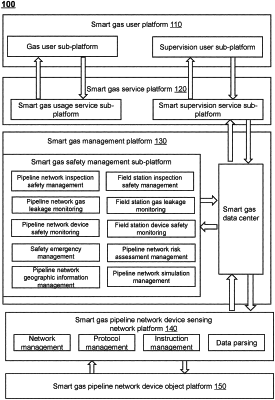| CPC F17D 3/01 (2013.01) [G16Y 10/35 (2020.01); G16Y 20/10 (2020.01); G16Y 40/35 (2020.01); G16Y 40/50 (2020.01)] | 5 Claims |

|
1. A method for managing a smart gas safety hazard item based on a Geographic Information System (GIS), wherein the method is implemented by a smart gas management platform of an Internet of Things (IoT) system for managing a smart gas safety hazard item based on a GIS and the method comprises:
obtaining gas safety hazard data of a gas pipeline network, wherein the gas safety hazard data includes a location of a historical safety hazard in the gas pipeline network and a safety hazard feature corresponding to the location, and the safety hazard feature includes at least one of a type of the safety hazard or a degree of the safety hazard;
dividing the gas pipeline network into one or more gas inspection units based on the gas safety hazard data and geographic information data of the gas pipeline network, wherein the geographic information data includes at least one of altitude data, perimeter road data, or vegetation data;
for each of the one or more gas inspection units,
assigning one or more gas safety hazard items to the gas inspection unit based on the gas safety hazard data corresponding to the gas inspection unit;
determining a processing plan of the gas inspection unit, including:
obtaining unit geographic information data and unit environmental data of the gas inspection unit based on the gas GIS;
determining an environmental complexity and a weather complexity of the gas inspection unit based on the unit geographic information data and the unit environmental data; and
determining the processing plan of the gas inspection unit based on the environmental complexity, the weather complexity, and the gas safety hazard item of the gas inspection unit, and historical unit safety hazard data, wherein the processing plan includes at least one of a processing priority, assignment of processing personnel, an environmental response plan, or a processing time; and
determining an inspection plan based on the processing plan and a gas GIS, wherein the inspection plan includes at least one of an inspection route, an inspection time, or inspection content of the gas inspection unit, wherein
the determining an inspection plan based on the processing plan and a gas GIS includes:
determining potential safety hazard data of different gas inspection units through a potential safety hazard prediction model based on the gas safety hazard data of the gas inspection unit, wherein the potential safety hazard data includes at least one of pending safety hazard data or impact safety hazard data, and the potential safety hazard prediction model is a machine learning model; and
determining the inspection route through a second preset algorithm based on the potential safety hazard data, the processing plan, and the gas GIS.
|